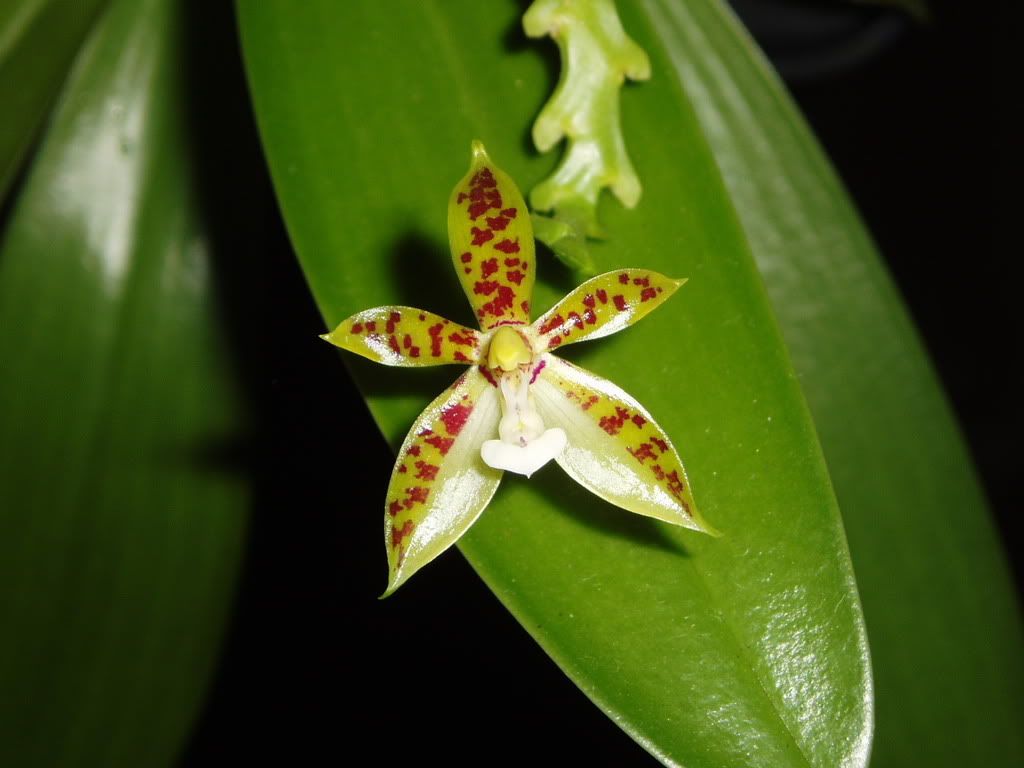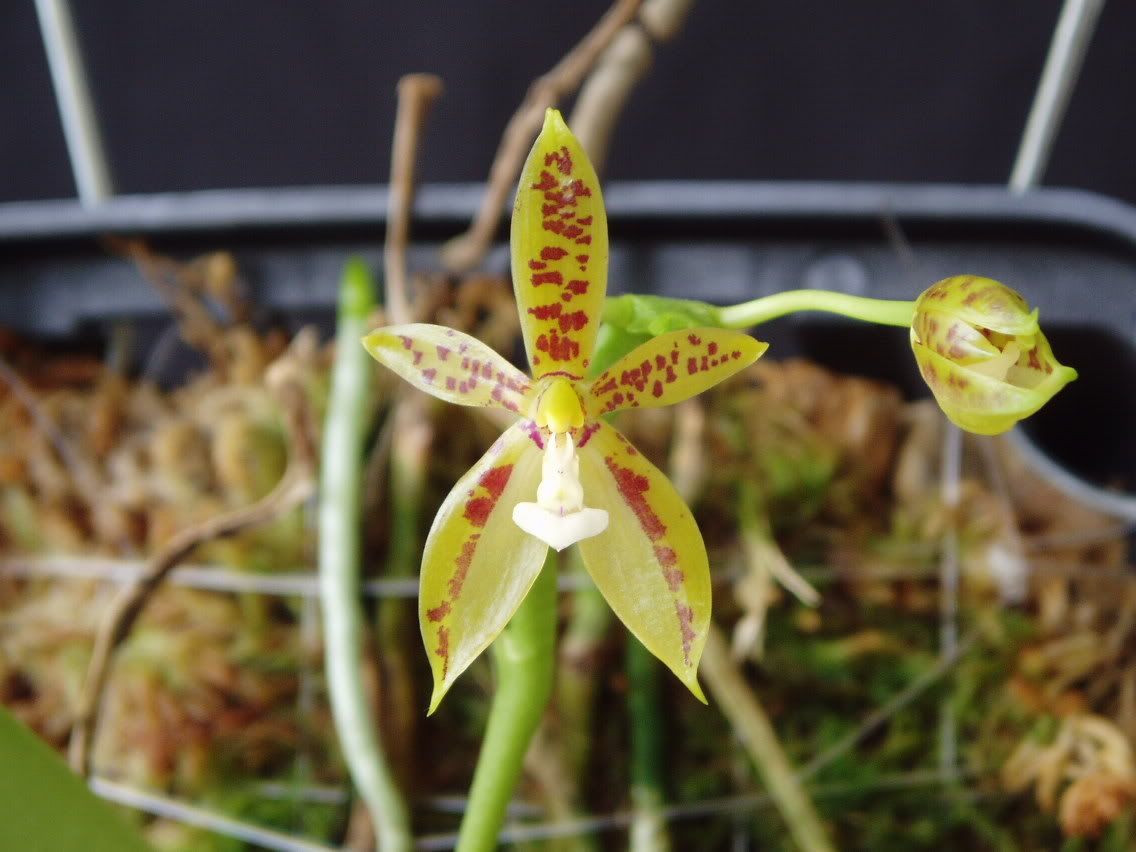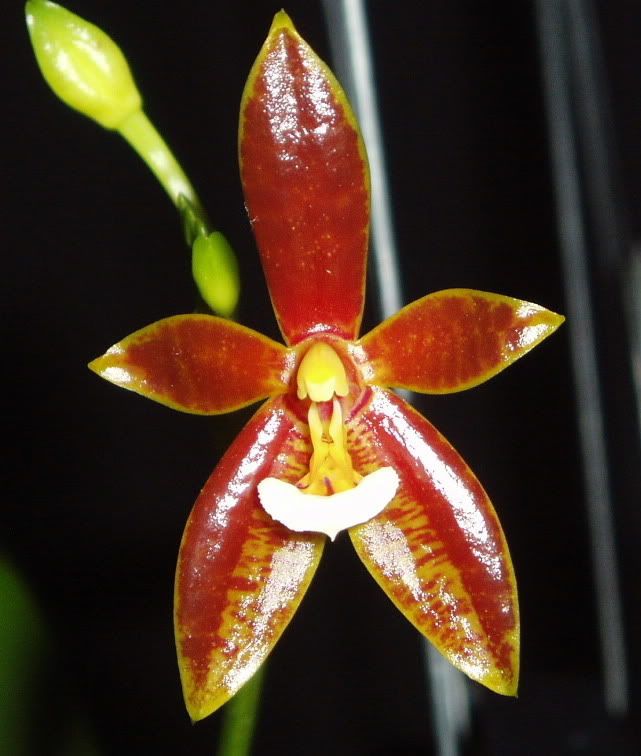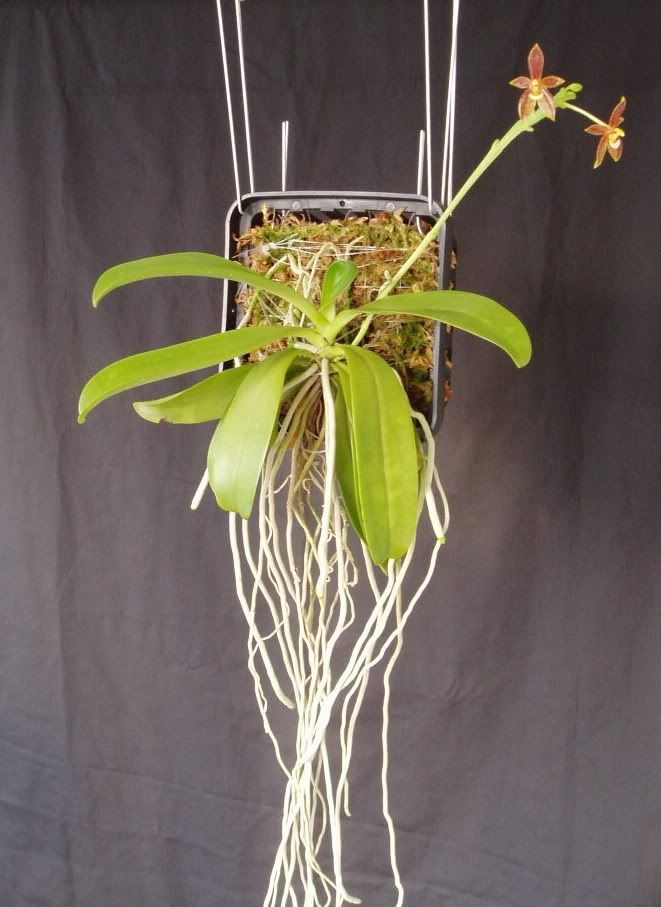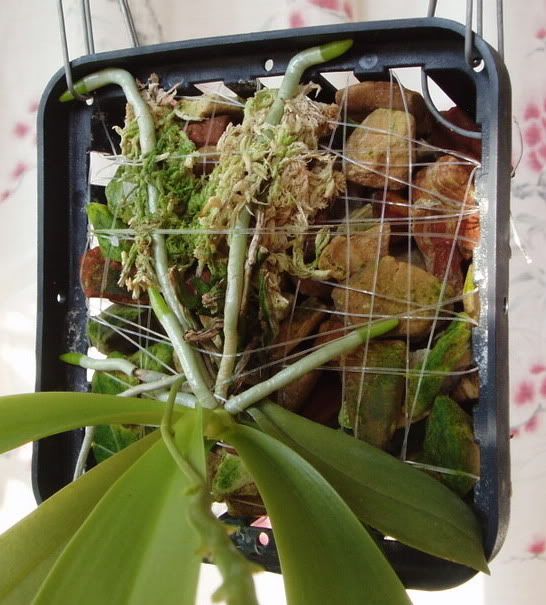June 30, 2007
June 28, 2007
Remounted (4)
The root mentioned in 130607 post, which came into contact with the diatomite, maintains the contact as it grows along the diatomite without any problems. The green growth tip has now gone out of sight as it grows into the medium. A second root has just touched the diatomite and will be observed for its reaction towards the medium.
More time is needed for observation to conclude if this culture (medium and watering regime) is more suitable for this phal cornu-cervi plant than the previous culture. It is still too early to conclude if the few hypothesis are right.
Algae has started to grow on both the sphagnum moss and diatomite surfaces exposed to light. Will be observing how the roots respond to these algae.
On the whole, the plant has been growing well since remounting. It did not shown signs of stress or slowing down due to the remount, and the flower bud is developing well.
More time is needed for observation to conclude if this culture (medium and watering regime) is more suitable for this phal cornu-cervi plant than the previous culture. It is still too early to conclude if the few hypothesis are right.
Algae has started to grow on both the sphagnum moss and diatomite surfaces exposed to light. Will be observing how the roots respond to these algae.
On the whole, the plant has been growing well since remounting. It did not shown signs of stress or slowing down due to the remount, and the flower bud is developing well.
Keikis {Plant 1}
.
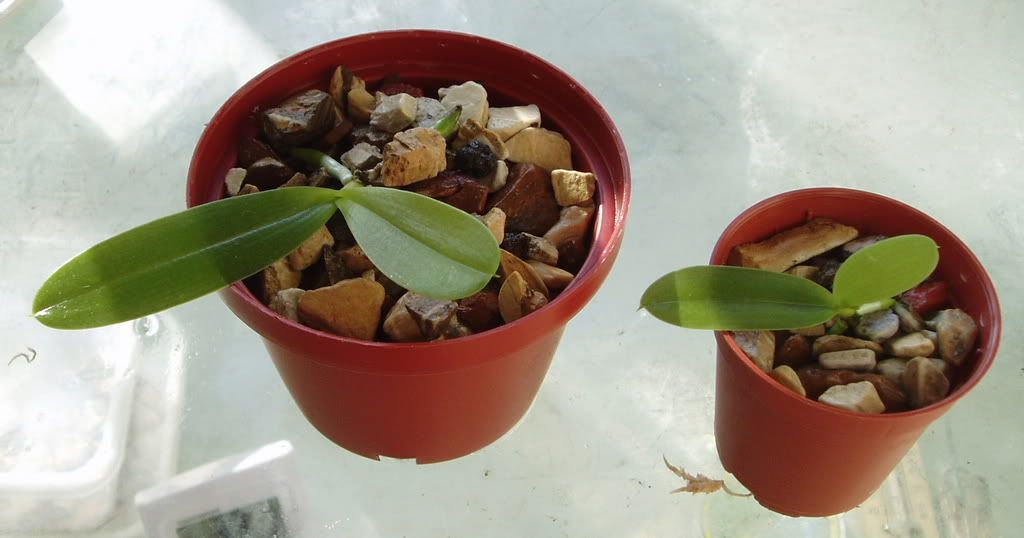
Two keikis appeared on the older of the two flowering spikes somewhere late last year. When the flowering spike died (turned browned and dried up) possibly due to a drastic decrease in watering during the wetter months, the keikis were removed and pushed into the sphagnum moss surface with the mother plant. At the time of removal, the keikis only had one leaf (~ 1 inch long) each. Also, the bigger keiki only had a young root starting to break through the epidermis of the main stem while the smaller keiki had none at all.
They had just grown their second leaf in the recent 2-3 months. An attempt to grow them on the diatomite surface together with the mother plant in the 120507 remount failed as water uptake by the keikis became a problem. The roots were hardly in contact with the diatomite and they dry up too fast after waterings to allow sufficient time for water absorption. Hence, they were removed from the basket a week after the remount and planted in pots of pure diatomite indvidually with daily waterings in the morning.
They had just grown their second leaf in the recent 2-3 months. An attempt to grow them on the diatomite surface together with the mother plant in the 120507 remount failed as water uptake by the keikis became a problem. The roots were hardly in contact with the diatomite and they dry up too fast after waterings to allow sufficient time for water absorption. Hence, they were removed from the basket a week after the remount and planted in pots of pure diatomite indvidually with daily waterings in the morning.
June 26, 2007
June 13, 2007
Plants not Flowering (2)

A flower bud was finally seen developing for plant 1.
The two main factors that could have contributed to the flowering of this plant after one year of vegetative growth are:
Change in culture: The new culture (medium and watering regime) following the remount suits the plant better than the original culture (refer to “Remount” for more). The plant had also been shifted to the lowest rank in the growing area early May, which directly translates to receiving an hour longer of morning sun. The mornings in the recent months are also clearer such that the plant receives unobstructed morning sun almost everyday. Thus, the plant may need more sunlight to bloom too.
Change in weather: This plant was bought in bloom on 01/07/06. The formation of the flower bud at the same period one year later could mean that this plant has a distinctive flowering season and that this season is here. The hotter days (>34 degrees) and night (~28 degrees) could be among the several stimuli for flowering.
Remounted (3)
The flaccid leaf became nearly turgid again a few days after sphagnum moss was stuffed under 2 of the roots. The plant has most probably received enough water with the culture (medium and watering regime) it is given now.
Existing roots are now all growing actively as seen from their fast growth rate and the healthy length (> 1 cm) of the green growth tip. Unlike when the plant was mounted on the sphagnum moss surface, the newer roots are now growing towards the medium. One of these roots that has came into contact with the diatomite (blocked by the plant in the photo) do not stop or slow down growth upon touching the diatomite unlike the original reaction upon touching the sphagnum moss surface. As this root grows, it remains in contact with the diatomite and maintains its cylindrical shape (do not become flat). However, the velamen layer of this root is still young and remains white during watering. I am not sure if this root is aiding in water absorption.
May 19, 2007
Remounted (2)
Plant is getting dehydrated as seen from one of the younger, fully developed leaves becoming increasingly flaccid over the days. None of the roots are in contact with the medium when the plant was remounted as there is no way they can be bent towards the medium. Older roots had been cut off during remount leaving behind mostly the younger roots.
One obvious reason for the dehydration is the lack of roots touching the diatomite to allow water uptake from the medium. Another reason could be the inability of newly formed valemen layers to absorb moisture for the living root cells below the white layer of dead cells to take in the moisture. The newly formed valemen layer behaviors like a layer of wax; it repels water and stay white during watering. Only after some weeks of maturing do the velamen layers start to absorb moisture and turn green during waterings. Water droplets on the new non-absorbent velamen layers and moisture trapped in mature absorbent velamen layers dry up too fast ( maybe less than an hour after watering) to allow adequate time for uptake of water.
To remedy the problem, some sphagnum moss was sandwiched between the diatomite surface and two of the roots (see photo in Remount 3)to allow them to absorb enough water through direct contact with the moisture retaining moss and prolonged moisture supply to the roots by the moss. The sphagnum moss becomes almost (sometimes completely) dry by the next morning (i.e. in one day's time) when the plant will be watered again.
One obvious reason for the dehydration is the lack of roots touching the diatomite to allow water uptake from the medium. Another reason could be the inability of newly formed valemen layers to absorb moisture for the living root cells below the white layer of dead cells to take in the moisture. The newly formed valemen layer behaviors like a layer of wax; it repels water and stay white during watering. Only after some weeks of maturing do the velamen layers start to absorb moisture and turn green during waterings. Water droplets on the new non-absorbent velamen layers and moisture trapped in mature absorbent velamen layers dry up too fast ( maybe less than an hour after watering) to allow adequate time for uptake of water.
To remedy the problem, some sphagnum moss was sandwiched between the diatomite surface and two of the roots (see photo in Remount 3)to allow them to absorb enough water through direct contact with the moisture retaining moss and prolonged moisture supply to the roots by the moss. The sphagnum moss becomes almost (sometimes completely) dry by the next morning (i.e. in one day's time) when the plant will be watered again.
May 12, 2007
Remounted (1) {Plant1}
This plant is remounted today.
The sphagnum moss on the front and sides of the basket are removed so that the plant will be mounted directly onto the diatomite surface instead of the original sphagnum moss surface. The new media now comprises mainly diatomite with a layer of sphagnum moss at the rear of the basket.
Watering regime is also altered to once every morning with the roots drying out between waterings, and the new medium becomes almost completely dry in about a day's time.
The sphagnum moss on the front and sides of the basket are removed so that the plant will be mounted directly onto the diatomite surface instead of the original sphagnum moss surface. The new media now comprises mainly diatomite with a layer of sphagnum moss at the rear of the basket.
Watering regime is also altered to once every morning with the roots drying out between waterings, and the new medium becomes almost completely dry in about a day's time.
Strange Root Behaviors (2)
As an effort to keep the growing area tidy, two long overgrown roots of plant (1) were pushed back into the medium a few months ago. The growth tips were pushed into the sphagnum moss layer until they touched or almost touched the diatomite. In the remount today, the 2 roots are found to have stopped growing the moment they were pushed into the moss. The growing tip did not venture deeper into the medium, and the originally green part of the growing tip was covered with velamen (the white layer).
This observation supports the hypothesize that roots of phal cornu-cervi dislike growing in sphagnum moss and/or perpetual moisture at its roots.
Root hairs are seen on the originally green part of the growing tips that have been covered with the velamen when they were pushed into the media. The contact with the moss and/or moisture of the moss could have induced the growth of these roots hairs for water absorption and anchorage.
This observation supports the hypothesize that roots of phal cornu-cervi dislike growing in sphagnum moss and/or perpetual moisture at its roots.
Root hairs are seen on the originally green part of the growing tips that have been covered with the velamen when they were pushed into the media. The contact with the moss and/or moisture of the moss could have induced the growth of these roots hairs for water absorption and anchorage.
May 03, 2007
Plants not Flowering (1)
Both plants (1) and (2) had not flowered for almost one year since purchased in early July 2006. This species should be relatively free-flowering and capable of blooming continuously year-round in Singapore's hot climate if the plant is established, mature, healthy and well cultivated. The main reasons why both my phal cornu-cervi plants are not flowering could be that both the watering regime (2-3 times weekly) and medium (same as for the majority of my phals) are not suitable for them, and that the root developments are poor (see Strange Root Behaviors) as a result of the unsuitable watering regime and media. Other possible reasons may include insufficient sunlight and lack of flowering stimuli ( i.e. it is still not the flowering season). Plants could also still be establishing and acclimatizing themselves.
Nurseries often sell phal cornu-cervi plants either grown in empty baskets with no medium or mounted on logs with no sphagnum moss. They are likely to be watered at least once a day* to compensate for the lack of moisture retaining media. Despite the absence of growing media, the high humidity in nurseries often keeps the roots moist longer thus giving more time for water absorption. Also, the high humidity may decrease transpiration rates thus minimizing water loss by plants. Heavy dew at night may also supply additional moisture to the roots. The roots dry out between the frequent waterings (or at least once a day) due to the lack of media to retain moisture; the roots are not not kept perpetually wet for long periods of time.
Thus, this phal species may respond better to frequent waterings with the roots allowed to dry out frequently between waterings as compared to watering 2-3 times weekly and keeping the roots perpetually moist for long periods.
They will be remounted soon with a change in medium and watering regime.
Nurseries often sell phal cornu-cervi plants either grown in empty baskets with no medium or mounted on logs with no sphagnum moss. They are likely to be watered at least once a day* to compensate for the lack of moisture retaining media. Despite the absence of growing media, the high humidity in nurseries often keeps the roots moist longer thus giving more time for water absorption. Also, the high humidity may decrease transpiration rates thus minimizing water loss by plants. Heavy dew at night may also supply additional moisture to the roots. The roots dry out between the frequent waterings (or at least once a day) due to the lack of media to retain moisture; the roots are not not kept perpetually wet for long periods of time.
Thus, this phal species may respond better to frequent waterings with the roots allowed to dry out frequently between waterings as compared to watering 2-3 times weekly and keeping the roots perpetually moist for long periods.
They will be remounted soon with a change in medium and watering regime.
Strange Root Behaviors (1)
The roots of both my phal cornu-cervi have been observed to be different from those of my other other phal species in many ways. Some of the roots are not attracted towards the medium; they grow almost parallel to the moss surface (without touching it) instead of growing towards it. Roots that have touched the sphagnum moss crawled along the moss surface instead of penetrating it and growing deeper into the medium. Furthermore, neither do they attach themselves to moss surface (they are hardly even in contact with the moss surface) nor flatten out upon touching the moss surface. The only root that penetrated the sphagnum moss layer exited immediately from the side of the basket and continued growing away from the basket.
In nurseries where they are grown in empty basket or mounted on logs without any media, well established phal cornu-cervi plants can easily have more than twice the number of roots as compared to other phal species. In addition, the proportion of these roots being free-hanging aerial roots can be much higher than that for other phal species. For plants mounted on logs, only a small minority of the roots actually attach themselves to the log and anchor the plant to the log. Roots attached to logs are not as flat as those for other phal species.
This may show that the roots of this species dislike growing in sphagnum moss. They may dislike growing in sphagnum moss for the crampness and perpetual moisture for extended periods of time. The roots may also prefer growing freely as aerial roots to growing attached to objects. Another possible reason is that the roots of my plants had been growing in air for too long before they touch the medium, hence becoming developed/specialized as aerial roots. Thus, they do not perform too well when they finally reach the medium.
In nurseries where they are grown in empty basket or mounted on logs without any media, well established phal cornu-cervi plants can easily have more than twice the number of roots as compared to other phal species. In addition, the proportion of these roots being free-hanging aerial roots can be much higher than that for other phal species. For plants mounted on logs, only a small minority of the roots actually attach themselves to the log and anchor the plant to the log. Roots attached to logs are not as flat as those for other phal species.
This may show that the roots of this species dislike growing in sphagnum moss. They may dislike growing in sphagnum moss for the crampness and perpetual moisture for extended periods of time. The roots may also prefer growing freely as aerial roots to growing attached to objects. Another possible reason is that the roots of my plants had been growing in air for too long before they touch the medium, hence becoming developed/specialized as aerial roots. Thus, they do not perform too well when they finally reach the medium.
Subscribe to:
Comments (Atom)

